In my opening horror film sequence, the opening shot will be an establishing shot of two girls in a plain, simple room with just a few book shelves and some plain furniture. They will be in the middle of the room, sitting opposite each other, and in between them is a Ouija board. The lighting will be candle light, but still quite bright. They will be laughing and joking about it, moving the glass around a lot. There will be an over-the-shoulder shot of them doing this, and the laughter will become quite distant and faint, and the light will get slightly dimmer. There will then be a close up shot of one of the girls laughing, and another close up of the other laughing still, but looking slightly unnerved. There is then a long shot, and the girls will decide to get up, walking out of shot through a door. The board in left abandoned in the middle of the floor. There is a zoom shot of the glass, and it will slowly start to move across the board on its own. As it is moving, one of the girls comes back in. There is a close up shot of the glass still moving, and then a mid shot of her staring at it in disbelief. There will be quite slow, sinister and repetitive music play, building up the tempo.
There is a mid shot of the board and the candles surrounding it will then suddenly go out together, leaving the room in darkness. All you will be able to hear is the gasp of the girl, then some fumbling and the striking of a match. There is a close up shot of the girls face, holding the candle below her chin, with just her face in light. She is breathing heavily, and then starts to shine the candle around the room slowly. The shot will be a panning shot, following the candle. It will pass over a bookshelf, the door, another bookshelf and then a very sinister masked face. She passes the candle over this, with the camera still following, then quickly pulls it back to where the face was. There are only old books illuminated by the candles. There is a mid shot of the girl who is holding her breath and still holding the candle up to the bookshelf and there is silence for a second, then the loud scream of the other girl is heard from the distance, and it cuts to black.





